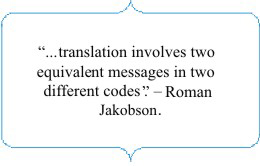Translation as Communication
It is an accepted fact in translation studies that translation is also an act of communication between two codes, that of the source language and target language. The problem occurs, as Annie Brisset points out when the two codes are not “isomorphic” or do not share similar patterns (qtd in Venuti 343). As Roman Jakobson puts it, “Languages differ essentially in what they must convey and not in what they may convey” (Venuti 116). The gap between the SL and TL is the hurdle that raises the question of translatability. As Jakobson points out even a category like grammatical gender is a problem. For instance, Hindi nouns have genders, and not all of them are logical. A chair which logically should have neutral gender is feminine. It becomes a problem when you are translating into a language where ‘chair' is masculine. The translator is left with no choice but to adopt the sensible way out which is translate according to the TL. If we agree with Gasset's notion this would amount to betrayal. The situation becomes more complex with literary texts as the language has other factors like word play and puns. Poetry, according to Jakobson, is untranslatable. He says: “Only creative transposition is possible: either intralingual transposition – from one poetic shape to another, or interlingual transposition – from one language into another, or finally intersemiotic transposition – from one system of signs into another, e.g., from verbal art into music, dance, cinema, or painting” (Venuti 118). between two codes, that of the source language and target language. The problem occurs, as Annie Brisset points out when the two codes are not “isomorphic” or do not share similar patterns (qtd in Venuti 343). As Roman Jakobson puts it, “Languages differ essentially in what they must convey and not in what they may convey” (Venuti 116). The gap between the SL and TL is the hurdle that raises the question of translatability. As Jakobson points out even a category like grammatical gender is a problem. For instance, Hindi nouns have genders, and not all of them are logical. A chair which logically should have neutral gender is feminine. It becomes a problem when you are translating into a language where ‘chair' is masculine. The translator is left with no choice but to adopt the sensible way out which is translate according to the TL. If we agree with Gasset's notion this would amount to betrayal. The situation becomes more complex with literary texts as the language has other factors like word play and puns. Poetry, according to Jakobson, is untranslatable. He says: “Only creative transposition is possible: either intralingual transposition – from one poetic shape to another, or interlingual transposition – from one language into another, or finally intersemiotic transposition – from one system of signs into another, e.g., from verbal art into music, dance, cinema, or painting” (Venuti 118). |